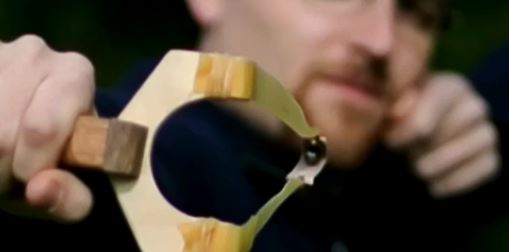














A pouch is the part of a slingshot that is connected to the rubber bands and holds the ammuniton.
If you attend a slingshot tournament and have a look at the slingshots, you'll be hard pressed to find a pouch not being crafted from leather. Only few materials can withstand the stress that the pouch experiences during the shot, and leather is both cheap and up to this job.
Choosing the right type of leather can be a bit challenging at first. It should be soft and flexible, lightweight and robust. A common choice is split leather from pig or cow, with a thickness of 1-2mm for normal draw weights. The best material is kangaroo leather. It withstands a lot of stress while being soft, flexible and lightweight. Please note that kangaroo leather must be cut in the correct direction, as it has strong fibres inside that run in one direction only.
Try to keep the pouch as lightweight as possible. It is accelerated together with
the projectile. This uses up energy that is diverted from the projectile's power.
The dimensions of a pouch vary greatly according to personal taste and choice of
ammunition. A typical "beginner size" to start with is 2x7cm. The pouch must always
be broader that the ammo's diameter. Thus, a big pouch allows you to shoot large caliber ammo
- which is quite important when you want to shoot stones, marbles or clay ammo - while
a small pouch increases the slingshot's performance.

The basic shape is a rectangle with two holes punched in. Leave enough material between holes and the pouches' border, else the holes will tear out. Their size depends on the type of rubber you use, but a diameter of 6mm usually serves you well.

It is always a good idea to make small cuts from the holes towards the center. This faciliates the attachment of the bands and also increases the holes' resistance against tearing out.

A centering hole helps you to load the ammunition perfectly into the center part of your pouch. This increases accuracy and loading speed. The hole must be a good deal smaller than the projectile you intend to use. It must also be perfectly centered. A poorly set centering hole does more bad than good!

There is some debate wether the pouches' edges need to be trimmed or not. It makes the pouch a little bit lighter, and some people say it helps to release the projectile cleanly. I think it is not worth the effort.

You can cut small slots in the middle section. This makes the pouch fold neatly along its middle axis every time, which is helpful with some ammo / pouch size combinations.